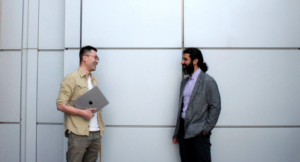The University of Utah was selected as a part of the SETO Operation and Planning Tools for Inverter-Based Resource Management and Availability for Future Power Systems (OPTIMA) funding program, an effort to develop new state-of-the-art planning and operations tools to enable solar energy to be more optimally and reliably integrated and utilized within the electric power grid, providing Americans with more affordable and secure clean energy.
Led by the University of Connecticut, the project will address emerging challenges and opportunities for grid planning and operation engineers and technicians arising from the power system’s transition to variable renewable energy sources and inverter-based power electronic grid interfaces.
Two Electrical and Computer Engineering professors at the University of Utah, Mingxi Liu and Mostafa Ardakani, have spearheaded the U’s involvement on this project as the largest sub-recipient of award funding.

Liu’s research group will focus on developing next-generation multi-agent reinforcement-learning (MARL) based methods for efficient, reliable, and robust control of variable renewable energy resources and distributed energy resources in transmission and distribution (T&D) operations. They will work to facilitate the grid integration of renewable energy and grid decarbonization. Ardakani’s research group will emphasize the development of a tool to identify T&D system components that are at risk during severe weather incidents. This tool will incorporate weather forecasts into decision software, guiding preventative measures and minimizing power outages.
As the power system transitions to renewable energy sources and inverter-based power electronic grid interfaces, the OPTIMA initiative will address emerging challenges and opportunities in grid planning and operation engineering. The tools and resources developed by Liu and Ardakani will assist the integration of distributed energy resources and inverter-based resources into the transmission and distribution grids, ultimately facilitating the grid decarbonization.
“The research and development activities planned in this project will construct critical steps for a future grid, which is more efficient, more reliable, more resilient, and more environmentally friendly,” says Ardakani.
Ardakani and Liu would like to thank their partners, especially PI Dr. Zongjie Wang of UConn, for their diligent work. They would also like to express their gratitude for the support from the US Department of Energy, DOE Office of Energy Efficiency & Renewable Energy, and DOE Solar Energy Technologies Office.
About The University of Utah
The University of Utah is the state’s flagship institution of higher education, with 18 schools and colleges, more than 100 undergraduate and 90 graduate degree programs, and an enrollment of more than 35,000 students. It is a member of the Association of American Universities—an invitation-only, prestigious group of 71 leading research institutions. Recently ranked #1 public university in the West by the Wall Street Journal, the U strives to be a model public university in delivering unmatched value in higher education and health care while making social, economic and cultural contributions that improve the quality of life throughout the state, the nation and the world.
About the Solar Energy Technologies Office
The U.S. Department of Energy Solar Energy Technologies Office accelerates the advancement and deployment of solar technology in support of an equitable transition to a decarbonized economy. Learn more at energy.gov/solar-office.
Written by Marlee Jeppsen